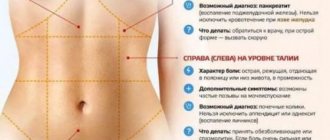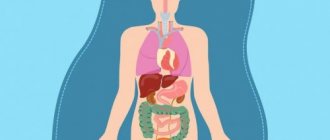According to WHO statistics, intestinal diseases are among the 10 most common pathologies of internal organs on the planet. Often the first sign of their appearance is pain in the left side at waist level. However, this symptom is characteristic not only of pathologies of the lower gastrointestinal tract; it is also observed in diseases of the reproductive system and inflammatory processes in the kidneys. Quite often, pain in the left side becomes a sign of serious life-threatening illnesses. Some of them can also cause infertility.
Clinical manifestations of pathology
The disease is characterized by the appearance of such typical symptoms that allow one to immediately suspect chronic gastritis:
- Heartburn is the appearance of discomfort and a burning sensation in the area behind the sternum. It may worsen when bending forward or in a horizontal position, when acidic gastric juice refluxes into the lower parts of the esophagus.
- Pain in the stomach area, namely in the epigastric region and in the upper parts of the left half of the abdomen. Most often they are aching or spastic in nature and occur 20-40 minutes after eating, which depends on the location of the inflammatory process.
- There is an unpleasant odor from the mouth and frequent severe belching that occurs after eating.
- Nausea almost always accompanies pathological changes in the stomach; in some cases, vomiting may occur.
- The abdomen is swollen, painful in the upper sections. The properties of the stool also change, most often towards constipation.
Diagnosis is based on the collection of complaints, an objective examination of the patient (pain in the abdomen in the projection of the stomach, a thickly coated tongue, a strong odor from the mouth) and data from fibroesophagogastroduodenoscopy (FEGDS). Treatment involves following a diet (table No. 1), taking antacid medications and, if necessary, carrying out eradication therapy against Helicobacter with a number of antibiotics.
Diseases of the intestinal tract
Abdominal bloating, which is accompanied by a violation of the act of digesting food, causing a feeling of fullness, rumbling and some other types of pathological conditions, is caused primarily by an unbalanced diet and consumption of harmful foods.
The pain is localized below the stomach. In addition, the occurrence of such a condition may be accompanied by previous surgical interventions performed in the abdominal area, malfunctions of the fermentation system, disturbances in the acid-base balance in the digestive tract, constant stressful situations, as well as deformations in the palate and teeth.
To eliminate this pathological condition, experts recommend using decoctions of medicinal plants for oral use.
Crohn's disease is an inflammatory process located throughout the digestive tract, with it a specific system of nodules begins to form on the mucous membrane of the oral cavity, throughout the digestive tract, right up to the anus.
A similar disease occurs in both the adult half of the population and young children. More often the pain is found in the lower abdomen.
The reasons for its appearance have not been fully identified by experts, but there are a number of predisposing factors, such as: excessive consumption of alcoholic beverages, genetic predisposition, allergic manifestations, viral infections, and constant nervous breakdowns.
The symptoms of this disease may vary depending on the location of the process. Therefore, at the slightest discomfort in the digestive tract, it is necessary to consult your doctor as soon as possible.
Reasons for appearance
There are many different factors that contribute to the appearance of pain in the left hypochondrium. But most of them are associated with disturbances in the functioning of the following internal organs:
- appendix;
- intestines;
- diaphragm;
- spleen;
- pancreas.
As practice shows, pain in the left side of women most often occurs with the development of gynecological diseases or inflammation of the genitourinary tract:
- malignant or benign formations;
- pain during menstruation;
- inflammation of the ovaries and fallopian tubes (uterine appendages);
- development of cystitis;
- cyst formation;
- rupture of the fallopian tubes;
- ectopic pregnancy.
If we talk about the male half, then in this case the range of possible reasons is noticeably narrowed. But, despite this, there are still quite a lot of problems that can cause pain in the left side:
- oncological diseases;
- development of cystitis;
- inguinal hernia;
- formation of stones in the prostate;
- inflammation of the prostate gland (prostatitis).
It is worth noting that in order to make an accurate diagnosis, it is necessary to determine the location of the pain (for example, pain in the back, in the lumbar region, under the ribs, etc.). This will allow doctors to find out which organ disease caused the pain.
Diagnosis for lower back pain
When there is pain on the left side of the spine above the lower back, you need to undergo a diagnostic examination. The doctor can check using the edge of the palm by tapping the lumbar region. Based on the results, he draws preliminary conclusions. When the problem is in the kidneys, such tapping is accompanied by an internal dull pain.
You can understand what pain is on the left side above the lower back after an X-ray of the lumbar region. The images clearly show intervertebral hernias, signs of osteochondrosis, and radiculitis. The patient is also offered to donate blood for a general analysis. Kidney diseases are usually accompanied by:
- anemia;
- anemia;
- high ESR.
Also, during diagnosis, it is recommended to take a urine test. Kidney disease here will be indicated by an increased salt content, leukocyturia, increased or decreased density of the composition. There are other signs of organ dysfunction. When there is pain in the back left above the lower back, it is worth undergoing such a test.
Another fairly accurate diagnostic method is ultrasound. This type of study is prescribed when there is a suspicion of a disease of the internal organs (for example, kidneys). Ultrasound diagnostics can detect an increase in organ volume, the presence of stones and other disorders.
Common diseases
It was previously noted that doctors associate the appearance of periodic or constant pain with diseases of the kidneys, gall bladder, colon, pancreas and other diseases. Below are the most common pathologies that may be accompanied by the appearance of characteristic pain at the waist level.
Table. Diseases that cause pain in the left side.
| Name of pathology | Description |
| A common disease of the genitourinary system, accompanied by inflammation of the bladder. As a rule, women suffer from cystitis, which is associated, first of all, with the anatomical features of the urethra - it is wider. The development of cystitis may be indicated by pain that spreads from the suprapubic region to the waist level. | |
| A urological disease of an infectious-inflammatory nature, which is accompanied by damage to the renal tubules and pyelocaliceal system. Often the disease occurs due to inflammation of the reproductive system, chronic infection, infection of the lower urinary systems, etc. One of the symptoms of the disease is a nagging pain on the left side. | |
| A rather dangerous disease, the development of which is indicated by pain in the navel area or in the left side. As a rule, the pain intensifies with movement or even while breathing. If the appendix is inflamed, urgent surgery is necessary, since ignoring the symptoms of the pathology can lead to serious consequences. | |
| This is an inflammation of the pancreas caused by a violation of the outflow of various enzymes, including gastric juice. The accumulation of these substances can negatively affect the health of the patient’s gastrointestinal tract, in particular, the pancreatic mucosa. Therefore, when the first symptoms appear (nausea, diarrhea, bloating, abdominal pain), you should immediately seek help from a doctor. | |
| Another common disease, during the development of which the patient experiences pain in the left side. The pathology is accompanied by inflammation of the colon mucosa. If left untreated, the inflammatory process can spread to the entire surface of the affected organ. | |
| An infectious kidney disease caused by infection with pathogens. According to statistics, more than 60% of all urological patients are patients suffering from various forms of pyelonephritis. Because the disease can affect either the right or left kidney, it also causes pain in the left side. |
Not only serious pathologies can cause discomfort or pain in the left side. Often, pain occurs due to improper or unbalanced nutrition, which provokes increased gas formation.
Diseases in the pancreas
Inflammatory phenomena in the pancreas, of a chronic nature, pass rather sluggishly, with rare exacerbations. This type of disease begins to develop against the background of dyskinesia of the entire gastrointestinal tract.
The symptoms of this type of disease are characterized by severe attacks of spasms, acute colic, attacks of nausea, flatulence, and changes in the skin. When treating inflammation in the pancreas, drug treatment is used.
The first step is to eliminate pain, inflammation, and also restore normal digestion. Treatment with drugs includes the use of painkillers, detoxification agents, antihistamines, enzymatic drugs and some others.
The acute form of pancreatitis is characterized by rapid development and occurs in elderly patients.
Manifestations of acute pancreatitis are characterized by pain in the front of the waist. The pain intensifies with movement.
It is also possible to increase the temperature and eruption of gastric contents, which does not bring the expected relief. A gray, dry coating forms on the patient's tongue, and purple circles appear around the eye area.
Read also: Heel hurts and it hurts to step on: what could be the reason?
Treatment of this disease is carried out only under the supervision of a specialist, in a hospital setting. The patient receives medications to relieve spasms.
Pancreatic cancer develops asymptomatically, and there are several varieties - adenocarcinoma, squamous cell carcinoma, acinar cell carcinoma.
As a rule, with the development of this oncology, the patient does not feel discomfort until the last stage.
If the following symptoms appear, you should contact a specialist as soon as possible:
- flatulence;
- stool disorder;
- attacks of nausea;
- pale stool;
- darkening of urine;
- lack of appetite;
- significant reduction in body weight;
- increase in blood sugar levels.
When to see a doctor
If the pain takes you by surprise, you need to seek help from a doctor as soon as possible, especially since the symptom often occurs without any previous signs.
Medical attention is required if the following additional symptoms occur:
- The pain is intense and growing in nature.
- The abdomen changed in size and became hard.
- Your temperature has risen, you experience general weakness and dizziness.
- Attacks of nausea and vomiting and diarrhea appeared.
- An admixture of blood and mucus in the vomit and feces.
- Sudden changes in pressure.
- Change in facial skin color.
- Tachycardia.
- Cold sweat. If the condition does not require urgent intervention, then you should contact a medical facility.
If dangerous symptoms appear, you should immediately consult a doctor for diagnosis. In this case, treatment should be carried out by a gastroenterologist, but the help of an immunologist, urologist or gynecologist may also be needed.
Character of pain in the left side at the waist level
The nature of pain in the left side at the waist level can be different:
- dull pain usually occurs in women due to the development of gynecological diseases. In addition, it can be triggered by mechanical damage and injury;
- pain in the left side at the waist level of a pulling nature often occurs during various infectious and inflammatory processes;
- sharp pain most often occurs due to diseases of the pelvic organs;
- stabbing pain syndrome is usually caused by problems with the spine, as well as increased gas formation;
In addition, the following types of pain are distinguished:
- visceral pain
. It occurs with spasms and stretching of organs; may be dull, aching and spasmodic in nature; - peritoneal pain
. It occurs against the background of irritation of the peritoneum. Her character can be sharp and harsh; - referred pain
. In this case, pain from the diseased organ can radiate to any place.
What to do during an attack?
In any case, it is necessary to call an ambulance when pain in the left side takes you by surprise. It is especially dangerous if such a symptom occurs without any previous signs. It is important not to take any action until the specialists arrive; you should lie down and take the most comfortable position in which you feel less pain.
You should urgently consult a doctor if you have pain in your left side at the waist level, and the following additional symptoms are present:
- Blood impurities in the stool.
- Periodically occurring vomiting with blood.
- Persistent diarrhea accompanied by nausea.
- Temperature increase.
- General weakness.
It is very dangerous if the pain in the left side gradually intensifies, that is, it is of an increasing nature. To make an accurate diagnosis, consultation with various specialists is often required. Treatment consists of eliminating the underlying cause, that is, it is necessary to cure the disease, after which the pain will disappear. During treatment, the doctor may prescribe painkillers or injections (non-steroidal anti-inflammatory drugs) to relieve discomfort. You cannot decide on your own to take any medications. You can relieve pain on the left side using folk remedies. But their intake should also be agreed with the doctor.
What can become inflamed on the left side of the abdomen?
Inflammatory processes in the left side of the abdomen are considered the most common pathology and the most dangerous to human life. With high intensity and weak protective forces of the body, they move from the organs to the layers of the peritoneum and cover the entire abdominal cavity.
This may be accompanied by severe peritonitis and death despite treatment. Inflammatory diseases have various causes. But they always manifest themselves as pain in the abdomen on the left, signs of organ dysfunction.
The inflammatory reaction is caused by microorganisms (pathogenic or conditionally pathogenic that have become dangerous), overirritation of organs with chemicals, toxic poisons, allergies to certain foods, an autoimmune process caused by an unclear hyperactivation of the immune system and the formation of antibodies to one’s own cells.
Signs of inflammation of each organ have their own characteristics, accompanied by ulceration of the mucous membrane, swelling of the parenchyma, impaired motility
Gastritis
Inflammation of the stomach is most often caused by infection with Helicobacter. This is an acid-fast microorganism that has chosen to “reside” in the pyloric zone. The disease occurs acutely (in case of poisoning with poor quality food, mushrooms, alcohol and its surrogates) or chronically with periods of exacerbation.
The severity of pain under the ribs and in the epigastrium depends on the form of the disease. Catarrhal gastritis is less severe. Intense sensations, vomiting, nausea, heartburn, belching, change from aching pain to sharp pain are observed with erosive, atrophic gastritis.
Impaired motility of the muscular layer of the stomach, spastic contractions or atony, difficulty passing the food bolus through the pylorus and sphincters leads to the formation of gastroesophageal reflux disease with the reflux of acidic contents into the esophagus or biliary gastritis.
When the esophagus is involved, the patient feels pain and burning above the epigastrium, behind the sternum. The discharge of bile from the duodenum is accompanied by concomitant bulbitis and biliary dyskinesia, causing irradiation of pain in the hypochondrium on the right.
Peptic ulcer
A stomach ulcer, manifested by pain on the left side of the abdomen, is localized in the body along the greater curvature. May be located in the upper part of the duodenum. The pain is sharp in nature. The increase is associated with food intake: after 30–60 minutes, stomach pain occurs, after an hour and a half, in the morning on an empty stomach or at night - from the intestines.
An ulcer differs from gastritis in the greater depth of the lesion
In the intervals between attacks, the pain is dull, the abdomen is swollen, the stool changes from diarrhea to constipation. The appearance of blood in the vomit and liquid black stool indicates bleeding. Intense symptoms are accompanied by vomiting, heartburn, and belching.
Sudden “dagger” pain poses a significant danger. She speaks of a complication of a peptic ulcer, perforation into the peritoneal cavity or into neighboring organs (penetration). Perforation is more often found in elderly patients taking long-term non-steroidal anti-inflammatory drugs and medications containing salicylic acid.
Penetration of duodenal ulcers occurs into the head of the pancreas. The pain syndrome is girdling in nature, the left side of the abdomen is involved and hurts.
Pain due to pancreatitis and other diseases of the pancreas
The pancreas is one of the important digestive organs. It communicates with the intestines through the main duct, which opens in the sphincter of Oddi together with the bile ducts.
Inflammation (pancreatitis) is accompanied by abdominal pain on the left side with limited spread only to the body and tail of the organ. With a total process, girdle pain of great intensity is characteristic.
The disease is often associated with alcoholism and cholelithiasis. It has an acute and chronic course. Accompanied by diarrhea with massive release of feces covered with a fatty film. Patients lose weight quickly. Intestinal function is disrupted.
The presence of a stone in the pancreatic duct, sphincter of Oddi, leads to blockage, stagnation of pancreatic juice and melting of its own tissues. More often, the pathology is expressed in right-sided pain, but significant necrosis of the parenchyma also involves the left side of the abdomen. Sometimes jaundice occurs.
A pseudocyst forms in the pancreas as an attempt to limit inflammation. In a separate cavity of the body of the organ, juice rich in enzymes accumulates. It forms within a few weeks following an attack of pancreatitis. The pain is weak and aching. The most important signs are signs of impaired absorption of fats and proteins, vitamin deficiency, and a tendency to bleed.
MRI - stage of diagnosing abdominal pain
An abscess is the formation of a cavity filled with pus in the pancreas. The reason is the addition of an infection against the background of acute pancreatitis with necrosis of part of the parenchyma. The condition worsens, the pain in the upper abdomen on the left becomes throbbing, and the temperature persists.
Spleen diseases
Surgeons note that in diseases of the spleen, severe pain syndrome is uncommon. The left side and stomach hurt moderately, the nature of the pain is bursting, pulling, and intensifies in the later stages of the disease.
Splenomegaly is expressed in a significant increase in the size of the organ (3 or more times), overflow with blood. More often observed with increased synthesis of blood elements, increased breakdown, in response to infection.
Severe abdominal pain and diarrhea
Accompanies liver cirrhosis with the development of portal hypertension. The nagging pain in the abdomen on the left, radiating to the left shoulder, is accompanied by signs of the underlying disease, and the temperature often rises.
Perisplenitis is inflammation of the capsule covering the spleen. Usually accompanied by damage to neighboring organs (intestines, left kidney, pancreas) or peritoneum. The degree of pain in the left half of the abdomen is determined by the severity of the inflammatory reaction.
Splenic infarction is formed when blood flow is disrupted, thromboembolism of the splenic artery. Thrombosis is preceded by severe atherosclerosis and cardiac arrhythmia. The situation threatens the patient's life due to necrosis of part of the organ and the possibility of massive internal bleeding. Clinically manifested by sudden pain in the left abdomen, nausea, vomiting, and fever.
Injuries can cause the spleen to rupture. First, the violations affect the internal structures, bleeding occurs into the parenchyma of the organ. In this case, the victim begins to hurt the left half of the abdomen and hypochondrium. Then the increasing internal pressure leads to rupture of the splenic capsule and hemorrhage into the peritoneal cavity. The clinic of hemorrhagic shock is developing.
The stage of splenic rupture can be determined by ultrasound image
Intestinal diseases
Part of the loops of the small and large intestines is located in the abdomen on the left side. Pathological changes are manifested by discomfort and pain on the side of the navel. Irritable bowel syndrome is a set of symptoms that indicate dysfunction of the large intestine.
These include abdominal pain on the left, alternating diarrhea or constipation. A direct connection of the syndrome with mental disorders and nervous exhaustion has been proven. The disease explains why people prone to depression and anxiety have stomach pain. The examination does not reveal any organic pathology.
Diverticulosis is caused by inflammation or birth defects. Pouch-like protrusions (diverticula) form from the intestinal wall. If they become inflamed, acute pain, nausea, vomiting, fever are observed, defecation and gas release are delayed. Most often the pain occurs in the lower left abdomen. This area is more susceptible to developing diverticulosis.
Enterocolitis is inflammation of the small and large intestines. Isolated damage to only the loops of the small intestine (enteritis) and the large intestine (colitis) is possible.
The causes of the disease are very diverse:
- pathogenic bacteria;
- dysbacteriosis of normal flora;
- autoimmune reactions;
- food poisoning;
- ingress of heavy metal salts;
- disturbance of blood flow in the vessels of the mesentery.
Symptoms include severe diarrhea with blood and mucus in the stool, pain along the intestines, bloating, loss of appetite, and fever. Nonspecific ulcerative colitis causes spasmodic pain in the lower left region closer to the groin, which intensifies during bowel movements and after physical activity.
Crohn's disease is a hereditary autoimmune pathology. It affects the entire digestive tract, but most often the intestines. Accompanied by persistent diarrhea, stabbing and aching pain, bloating, and weight loss. Children in adolescence and young adults are most susceptible. The course is long-term with the formation of cicatricial changes that impede patency.
Spastic and atonic constipation occurs due to the loss of the regulatory function of large intestinal motility. Delayed emptying leads to intoxication of the body, causing cramping pain (with spasm) or distension (with atony).
Pathology can develop due to the use of certain medications, as a result of hormonal disorders, and frequent stress
Intestinal obstruction is formed by persistent spasm, blockage of the intestinal lumen with fecal stones, torsion of diverticula, adhesions, and tumor. In this case, the passage of the contents stops, the higher located part swells. Depending on the cause, the pain intensifies gradually or occurs suddenly.
Nausea, vomiting, and lack of audible intestinal motility allow a correct diagnosis to be made.
Diseases exclusively of the rectum (proctitis, paraproctitis) are caused by infection of the mucous membrane, hemorrhoids. They are characterized by intense pain in the left side, iliac region, extending into the anus, intensified by defecation, and tenesmus (false urges).
Tumors
A sign of tumor growth is pain in the left half of the abdomen. The pathology is extremely serious in its consequences. It is very important to take into account that the pain sign appears already with a significant process, metastases.
In the initial stages, malignant neoplasms are disguised as sluggish diseases, causing a feeling of fullness in the abdomen, loss of appetite, unstable stool, and an incomprehensible increase in temperature.
In the left half of the abdomen, pain is observed with cancer of the body and tail of the pancreas, stomach (in the upper part), in the lateral and iliac region with colorectal cancer of the large intestine. At the same time, symptoms of intestinal obstruction (retention of stool, gases) appear.
Statistics show that with cancer of the left half of the colon, sigmoid and rectum, the survival rate of patients is higher than with the tumor located in the right half
Diseases of the urinary organs
Inflammation of the left kidney (pyelonephritis) causes intense bursting pain in the left side. They intensify with movement, are accompanied by pain and frequent urination, increased temperature with chills and sweating.
Calculous pyelonephritis and urolithiasis are pathogenetically related to a violation of the passage of urine through the renal pelvis and ureters. Stagnation provokes inflammation, and vice versa, inflammation increases the risk of stone formation. Urinary dysfunction is especially dangerous for a pregnant woman.
Renal colic on the left is accompanied by intense pain in the lower back and abdomen, radiating to the scrotum in men and to the groin in women. At the same time, the patient is excited, screams in pain, and urination is delayed due to painful urges. The attack may end on its own without treatment if the stone passes in the urine. Typically, bleeding occurs at the end of urination due to injury to the ureteral mucosa.
Nephroptosis or prolapse of the left kidney by more than 2 cm at the height of inspiration occurs after pregnancy, injury, or with sudden weight loss. The main symptom will be severe pain in the left hypochondrium, lower back and lower abdomen. It intensifies in an upright position, decreases while lying down (the kidney goes back to its normal position).
Hydronephrosis is formed when there is a long-term disruption of the outflow of urine from the kidney; the destroyed pelvis and calyces turn into one large cavity. When enlarged, the renal tubules and nephrons are compressed and die.
Left-sided hydronephrosis causes dull aching pain in the left side of the abdomen, lower back, radiating to the groin. The left kidney stops functioning. Excretion of urine is carried out only by increased load on the right organ.
Pain caused by tension in the renal capsule
Muscle pain and neuralgia
If pain in the left upper abdomen appears when moving, coughing, or taking a deep breath, then we can conclude that it is of muscular origin. Intercostal neuralgia is caused by hypothermia, increased physical activity, and uncomfortable posture when working.
Radicular pain with pinching of branches emanating from the bone canals of the spinal cord occurs in patients with spinal osteochondrosis. If there is a lesion in the lower thoracic and lumbar regions, irradiation to the left side and abdomen is possible.
The difference in symptoms and variety of pathologies accompanied by pain in the left half of the abdomen require timely examination of the patient, consultation and treatment by specialists.
Prevention
Prevention of pain on the left consists, first of all, of undergoing regular medical examinations. If the pathology is detected at an early stage of development, it can be successfully treated.
Since the most common cause of pain on the left side of the waist area is stomach problems, it is necessary to normalize your diet and eliminate harmful foods from your diet. These include fast food and convenience foods. In addition, the menu needs to minimize the number of hot and spicy dishes. You need to eat only high-quality foods. Food must be fresh; at the slightest suspicion that the product is expired, it must be thrown away. It is important to pay attention to your diet. It is advisable to eat at the same time, and overeating should also be avoided.
To prevent the development of osteochondrosis, it is necessary to lead an active lifestyle. If your main activity is related to a sedentary, passive lifestyle, then it is important to additionally exercise. To keep the spinal column healthy, it is necessary to avoid heavy physical activity. This will reduce the risk of slipped discs. It is important to monitor your posture. With a straight back, the load is distributed evenly, therefore minimizing the likelihood of accidental damage to the spinal column. It is very important to try to get rid of excess weight.
Prevention of any diseases that can cause pain on the left side can be considered a generally healthy lifestyle. It is important to take care of moderate exercise and proper rest. If possible, it is necessary to exclude stressful situations and nervous tension. We must strive to live in a positive attitude. Taking good care of your health will allow the body's natural defense reactions to work at the appropriate level, which will reduce the risks of various infections.










